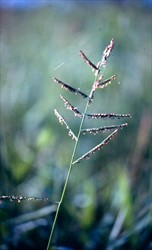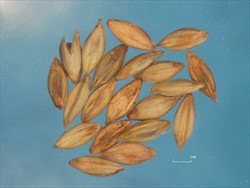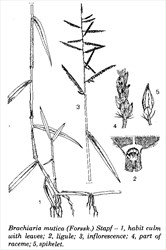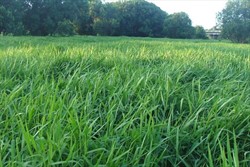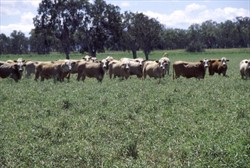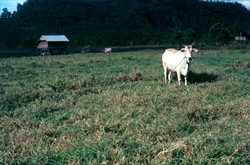Urochloa arrecta & U. mutica
Tropical Forages
Urochloa arrecta (Hack. ex T. Durand & Schinz) Morrone & Zuloaga
Urochloa mutica (Forssk.) T.Q. Nguyen
U. arrecta: Basionym: Panicum arrectum Hack. ex T. Durand & Schinz; Brachiaria arrecta (Hack. ex T. Durand & Schinz) Stent; Brachiaria latifolia Stapf; Brachiaria radicans Napper
U. mutica: Basionym: Panicum muticum Forssk.; Brachiaria mutica (Forssk.) Stapf; Panicum barbinode Trin.; Panicum purpurascens Raddi
Family: Poaceae (alt. Gramineae) subfamily: Panicoideae tribe: Paniceae subtribe: Melinidinae.
Urochloa arrecta: Perennial, culms rambling, 30–130 cm long, rooting from lower nodes; culm nodes glabrous or pubescent. Ligule a fringe of hairs. Leaf-blades 5–25 cm long, 5–15 mm wide. Inflorescence composed of racemes. Racemes 4–15, borne along a central axis, unilateral, 1–10 cm long. Central inflorescence axis 5–25 cm long; rachis broadly winged, 0.5–1.5 mm wide, scabrous on margins, glabrous on margins. Spikelet packing adaxial, regular, 2 -rowed. Spikelets solitary; fertile spikelet sessile; fertile floret without rhachilla extension; spikelets elliptic, dorsally compressed, compressed slightly, acute, 3–4.3 mm long, falling entire; rhachilla internodes brief up to lowest fertile floret. Glumes dissimilar, reaching apex of florets, thinner than fertile lemma; lower glume ovate, ⅓ - ½ length of spikelet, membranous, without keels, 3–5-veined; lower glume apex acute, upper glume oblong, length of spikelet, membranous, without keels, 5–7-veined, apex acute. Basal sterile florets male, with palea; lemma of lower sterile floret similar to upper glume, oblong, length of spikelet, membranous, 5-veined, acute. Fertile lemma elliptic, 2.5–4 mm long, indurate, without keel, surface rugulose, margins involute, apex obtuse, muticous, or mucronate; palea involute indurate, without keels.
Urochloa mutica: Perennial, culms rambling, 25–125 cm long, rooting from lower nodes; culm nodes densely bearded. Ligule a fringe of hairs. Leaf-blades 6–30 cm long, 3–15 mm wide. Inflorescence composed of racemes. Racemes 5–20, borne along a central axis, unilateral, 2–10 cm long; simple, or secondarily branched. Central inflorescence axis 7–20 cm long; rachis broadly winged, 0.5–1 mm wide, scabrous on margins, glabrous on margins. Spikelet packing irregular. Spikelets in pairs (occasionally only few paired spikelets in each raceme); fertile spikelet sessile and pedicelled, 2 in the cluster, pedicels bearing a few hairs; fertile spikelets comprising a basal sterile floret and a fertile floret, without rhachilla extension. Spikelets elliptic, dorsally compressed, compressed slightly, acute, 2.5–3.5 mm long, falling entire; rhachilla internodes brief up to lowest fertile floret. Glumes dissimilar, reaching apex of florets, thinner than fertile lemma; lower glume ovate, ¼ - ⅓ length of spikelet, membranous, without keels, 3–5 -veined; lower glume apex acute; upper glume oblong, length of spikelet, membranous, without keels, 5–7 -veined, apex acute. Basal sterile florets male, with palea; lemma of lower sterile floret similar to upper glume, oblong, length of spikelet, membranous, 5-veined, acute. Fertile lemma elliptic, 2–3 mm long, indurate, without keel, surface rugulose, margins involute, apex obtuse, muticous, or mucronate; palea involute, indurate, without keels, surface rugose.
Based on: Clayton, W.D., Vorontsova, M.S., Harman, K.T. and Williamson, H. (2006 onwards). GrassBase - The Online World Grass Flora. http://www.kew.org/data/grasses-db.html. (accessed 18 November 2018).
Distinguishing features
U. arrecta is closely related to, and morphologically similar to U. mutica, the most apparent difference being that spikelets are borne singly in 2 rows on the rachis in U. arrecta, and paired or clustered on the rachis in U. mutica, although often singly in the upper part of the raceme. Other morphological differences are largely relative, with considerable dimensional overlap between the two species, making them unreliable as a means of distinction.
Urochloa arrecta
Africa: ladikoro (Nigeria, Yoruba); kussein (Mali)
English: African liverseed grass, African signal grass, tanner grass, Joe Tanner's grass
Latin America: bracquiaria do brejo, capim tanner, capim tanner-grass (Brazil); pasto señal africano, pasto taner, pasto tanner (Bolivia, Colombia, Costa Rica, Ecuador, Panama, Peru, Venezuela)
U. mutica
Africa: feflik, aelaek, faelek, faeleq, feleq (Arabic); konya, kussein (Mali); burgu, shémé, talud, talul (Niger); bauna, birbet, ladikoro, zarin bauna, zaza (Nigeria)
Asia/Pacific: smau kôô (Cambodia); 巴拉草 ba la cao (China); mauku puakatoro (Cook Islands); jukut inggris, rumput malela, sukut kolonjono (Indonesia); para-gurasu (Japan); rumput melela, rumput para (Malaysia); babaka-nalabaga, mara-kawayan (Philippines, Ilokano); yaa khon, ya khon (Thailand); puakatau (Tonga); cỏ lông tây, cỏ lông Para (Vietnam)
Asia South: para ghah (Assamese); nardul (Bengali); para ghas (Gujarati, Hindi); Mauritius hullu (Kannada); para gavat (Marathi); ghara ghasa (Oriya); diya tana (Sinhalese); enumugaddi (Telugu); neerpul (Tamil, India); tanni pul (Tamil, Sri Lanka)
English: African wonder grass, Angola grass, buffalo grass, Californiagrass, Carib grass, cori grass, Dutch grass, giant couch, Mauritius (signal) grass, Numidian grass, panicumgrass, para grass, Penhalonga grass, Scotch grass, Scottish grass, water grass
Europe: herbe de Para (French); Paragras (German)
Latin America: Angola, bengo, capim Angola, capim angolinha, capim bengo, capim Colonia, capim de boi, capim de muda, capim fino, capim de planta, capim de Pará (Portuguese); admirable, capin, Egipto, camalote, camelote, egipto, grama de Pará, gramalote, hierba de Pará, hierba del Pará, leh-toom, malojilla, malohillo, malojillo, Nilo, Pará, Paraná, pasto admirable, pasto de laguna, pasto malojillo, pasto Pará, pasto pare, piojillo para, quixi-coba, sagádi pará, yerba del parral, zacate camalote, zacate colorado, zacate egipto, zacate Pará (Spanish)
U. arrecta × U.mutica
English: Tangola grass
Latin America: pasto braquipará, pasto brachipará; tangola
Urochloa arrecta
Native:
Africa: Angola, Botswana, Kenya, Malawi, Namibia (n.e.), South Africa (Cape Province (e.), KwaZulu-Natal, Transvaal), Tanzania, Uganda, Zambia, Zimbabwe
Cultivated:
Caribbean: Trinidad and Tobago
South America: Brazil, Colombia, Venezuela
Naturalized:
Northern America: USA (Florida)
Caribbean: Puerto Rico
South America: Brazil (Bahia, São Paulo), Colombia, French Guiana, Venezuela
Urochloa mutica
Native:
Africa: probable origin tropical Africa
Cultivated/naturalized:
Indian Ocean: Mauritius, Réunion
Asia: Indonesia, Japan, Malaysia, Taiwan, Thailand, Vietnam
Australasia: Australia, New Zealand
Pacific: American Samoa, Cook Islands, Fiji, French Polynesia, Galapagos Is, Guam, Hawaii, Marshall Islands, New Caledonia, Samoa, Tonga
Northern America: Mexico, USA
Caribbean: Cayman Islands, Cuba, Hispaniola, Jamaica, Puerto Rico, Virgin Islands (U.S.) [St. Croix]
Central America: Costa Rica, Honduras, Panama
South America: Argentina, Bolivia, Brazil, Colombia, Ecuador, Peru, Venezuela
Forage
U. arrecta and U. mutica are well-suited to permanent pasture in high rainfall or waterlogged environments, including shallow ponded pasture. Where conditions are favourable, also suited to conserving as silage, haylage or hay.
Environment
They form a dense mat and provide good ground cover to protect against soil erosion in wet or high rainfall areas. Often used for stabilizing dam walls.
Soil requirements
Well adapted to a wide range of soil types (from sandy to clay soils) of moderate to high fertility. Tolerate moderate salinity and high aluminium, as well as a wide range of soil reaction from pH 4 to 8 and the high levels of trace elements normally produced under water-logged conditions.
Moisture
The main environmental characteristic limiting the distribution of these two Urochloa spp. is moisture availability. They are semi-aquatic grasses normally found in swampy and seasonally flooded grassland in humid to sub-humid regions with (900‒) 1,200‒4,000 mm annual rainfall. They are adapted to acquatic conditions by virtue of hairy leaves and long hollow stems that float on water, and develop adventitious rootlets, terrestrial roots being intolerant of continuous submergence. They can grow in water to over 1 m deep in the tropics, but only up to 30 cm in the subtropics, and can tolerate periods of inundation up to 1 month. They remain productive in well-drained soils providing they retain their high moisture status, and can survive for up to 6 months with minimal moisture although remaining unproductive during dry periods. The U. arrecta × mutica hybrid, tangola grass, is more drought-hardy than the parents.
Temperature
They grow in the tropics from 0 to 2,000 m asl (better below 1,800) and in the lowland subtropics, providing moisture conditions are suitable. Warm season growth only, with growth restricted by temperatures below 15 ºC in U. mutica, with 21 °C the optimum mean growth temperature, and 8 °C the minimum for persistence. Both are frost sensitive, and although leaf is killed by frost, plants mostly recover with the advent of warmer conditions. Frost damage is often minimized in semi-acquatic systems.
Light
They are tolerant of light shade but prefer full sun. Shade tolerance is lower than that of U. decumbens. Shade intensity under mature coconuts renders them prone to weed invasion.
Reproductive development
Reproduction in U. mutica is apomictic and U. arrecta largely sexual. Both reproduce vegetatively by stolon segments. U. mutica is a short-day species that flowers most prolifically in humid environments at latitudes of 10–20º. In northern Australia, it flowers in late April/early May and sets seed in late May. Dry conditions may stimulate flowering in the subsequent wet season, and adequate soil N may also stimulate flowering and seed set. Little or no flowering is reported at subtropical latitudes.
Defoliation
They can withstand heavy grazing for relatively short periods, but under constant heavy grazing, the sward of the palatable grass may become very open and subject to invasion by undesirable tropical weeds such as Chromolaena odorata, Cyperus aromaticus, Mimosa diplotricha, Sida spp., or unpalatable tussock grasses such as Paspalum quadrifarium on better drained soils, or acquatic weeds such as Mimosa pigra in swampy land. Moderate grazing pressure may be required to reduce seed set and maintain forage quality in highly productive environments. They are also susceptible to regular cutting below 5 cm, the optimum harvest interval ranging from about 30 days in the rainy season to 55–60 days in the dry season. Sward height is best maintained at greater than 20 cm to prevent weed ingress.
Fire
Fire is rare in its habitat but the dense stands rapidly regenerate from any damage that they suffer. Their ability to produce a bulk of fuel in the wet season when not grazed, together with subsequent hot fires have caused them to be regarded as environmental weeds in ungrazed wetland environments in some countries.
Guidelines for establishment and management of sown forages.
Establishment
Both grasses are readily established from vegetative sets, hand-planted or disc-harrowed to a depth of 10–15 cm. Plant sets should be 25–30 cm long with 3–4 nodes (at least 2 nodes buried), and planted into moist soil, where they root readily at the submerged nodes. Complete ground cover can be achieved within 8 months after planting at 1,000 hills/ha. For mechanical vegetative planting, a planting rate of 2.5–4.5 t/ha stem cuttings is desirable, and will establish more quickly than Cynodon nlemfuensis, Urochloa ruziziensis or Digitaria eriantha (pangola grass). They can also be sown from seed at a rate of 3–4 kg/ha, but seed is not generally available.
Fertilizer
Respond well to nitrogen fertilizer under moist growing conditions. DM productivity can be sustained by the addition of companion legumes contributing 20–30% of DM. May respond to P in low P soils.
Compatibility (with other species)
U. arrecta and U. mutica are generally grown in monospecific swards, but if carefully managed can be grown with a range of legumes in the moist better-drained conditions. In acquatic/semi-acquatic systems (including ponded pasture), lower-growing grasses such as Paspalum distichum are found in the shallow water, giving way to these Urochloa spp. as the water deepens, and ultimately to Echinochloa polystachya and Hymenachne amplexicaulis in the deepest water (ca. 1.2 m).
Companion species
Grasses: Acquatic environment: Echinochloa polystachya, Hymenachne amplexicaulis. Not planted with other grass in free-draining soils.
Legumes: Macroptilium lathyroides, Aeschynomene americana on poorly-drained soils, and Neustanthus phaseoloides, Centrosema molle, Neonotonia wightii on free-draining soils, where Calopogonium mucunoides may also persist because of its low palatablity. While Arachis pintoi is adapted to similarly suitable moist, well-drained soils, it may not be compatible with these species under the more lenient defoliation necessary for grass persistence.
Pests and diseases
Insect pests and diseases vary with region, rarely sustaining serious damage. They are relatively resistant to cercopid spittlebug, but are attacked by chinch bugs (Blissus antillus and B insularis, both Hemiptera: Blissidae), as is the hybrid, tangola grass (U. arrecta × B. mutica). The pasture leafhopper (Toya sp. Hemiptera: Cicadellidae) can cause damage that leads to the observed ‘leafhopper burns’ in wet winters. Larvae of the common armyworm (Mythimna convecta) and the African armyworm (Spodoptera exempta, both Lepidoptera: Noctuidae) and of the striped grass looper (Mocis latipes Lepidoptera: Erebidae) cause leaf damage. Para grass is a host for the sugarcane rootstock weevil (Apinocis subnudus Coleoptera: Curculionidae). Blast caused by Pyricularia oryzae, sheath blight caused by Rhizoctonia sp. and rust caused by Uredo gharsii and Uromyces setariae-italicae affect the foliage and head smut possibly caused by Tilletia ayresii affects the inflorescence. These pests and diseases do not necessarily afflict both species.
Ability to spread
While both are capable of setting seed, the majority of spread is vegetative by runners.
Weed potential
Both grasses can be a nuisance in crops, but the major concern lies in the fact that they invade wetlands of conservation value.
Nutritive value
These are typical tropical grasses, the nutritive value being largely a reflection of age of regowth and fertility of the soil.
Palatability/acceptability
Both are very palatable to livestock.
Toxicity
U. arrecta can cause nitrate/nitrite poisoning in cattle when grown on fertile soils and ingested as 100% of the diet. Intoxication symptoms were observed after 4 days on the grass at flowering stage. Photosensitization and anaemia in horses and sheep has also been reported in animals grazing U. arrecta. Nitrate poisoning has not been reported in U. mutica, but it may contain sufficient calcium oxalate to cause nutritional secondary hyperthyroidism in horses grazing dense swards.
Feedipedia link
https://www.feedipedia.org/node/486 (Para grass)
Dry matter
Yields of the order of 30 t/ha/year DM have been recorded for both species when well-fertilized and irrigated, but more commonly range from 5 to 15 t/ha/year DM under farm conditions. The natural hybrid, tangola grass, is more productive than either parent.
Animal production
Cattle have gained 0.47 kg/head/day (860 kg/ha at a stocking rate of 5 head/ha) grazing U. arrecta, and 0.56 kg/head/day over 448 days grazing the same grass fertilized with 100 kg/ha N. Under wetland or irrigated conditions, liveweight gains of 300–800 kg/ha/year have been recorded under stocking rates up to 3 beasts per hectare on U. mutica. Steers grazing pure para grass pastures have gained 511 kg/ha/year liveweight, averaging 0.55 kg/head/day over a 3-year period, whereas cattle grazing para grass/legume pastures produced 621 kg/ha/year liveweight and averaged 0.65 kg/head/day over the same period. In subtropical, coastal Australia, irrigated para grass-centro (Centrosema molle) pastures supported steer liveweight gains of 0.96 kg/head/day.
U. arrecta and U. mutica are both tetraploids (2n = 4x = 36). U. arrecta has reasonably regular bivalent chromosome pairing and sexual reproduction, while U. mutica has irregular chromosome pairing and apomictic reproduction. A sterile spontaneous B. arrecta × B. mutica hybrid, now known as "tangola grass", was collected in 1968 in the Itabapoana Valley (Rio de Janeiro State) in Brazil in a pasture containing U. arrecta and U. mutica.
Seed production is generally not considered important with either of these grasses since they are both most easily established vegetatively in the preferred wet habitat. Mechanical harvesting would be difficult in the highly productive, poorly drained environments of the wet tropics. Seed yields of U. mutica are low with yields of 10–30 kg/ha from mechanical or hand harvest, and it does not flower at all in the subtropics.
U. mutica as can be controlled with glyphosate (720 g a.i. in 200 L/ha water) applied to actively growing plants at the early head stage. Care should be taken to avoid spray entering the water in acquatic systems. Glyphosate alone may not kill U. arrecta, but when combined 50:50 with imazapyr, effective kill can be obtained.
- Grows in wet and flooded country.
- Withstands heavy grazing.
- Salt tolerant.
- Photosensitization and nitrate toxicity in U. arrecta.
- Possible oxalate problems with horses grazing U. mutica.
- Weeds in sugarcane.
Bogdan, A.V. (1977) Tropical Pasture and Fodder Plants. Longman Inc., New York, USA. p. 59–64.
Ghimire, S., Njarui, D., Mutimura, M., Cardoso, J., Johnson, L., Gichangi, E., Teasdale, S., Odokonyero, K., Caradus, J., Rao, I.M. and Djikeng, A. (2015) Climate-smart Brachiaria for improving livestock production in East Africa: Emerging opportunities. Proceedings of 23rd International Grassland Congress 2015. Keynote Lectures. Jhansi, Uttar Pradesh, India. p. 361–370. hdl.handle.net/10568/69364
Goes, R.H.T.B. de, Mancio, A.B., Lana, R.P., Valadares Filho, S.C., Cecon, P.R., Queiroz, A.C. and Costa, R.M. (2003) Avaliação qualitativa da pastagem de capim tanner-grass (Brachiaria arrecta), por três diferentes métodos de amostragem. Revista Brasileira de Zootecnia 32:64–69. doi.org/10.1590/S1516-35982003000100008
Keller-Grein, G., Maass B.L. and Hanson J. (1996) Natural variation in Brachiaria and existing germplasm collections. In: Miles, J.W., Maass, B.L. and Valle, C.B. do (eds) Brachiaria: Biology, Agronomy, and Improvement. CIAT, Cali, Colombia. p. 16–35. hdl.handle.net/10568/54362
Maass, B.L., Midega, C.A.O., Mutimura, M., Rahetlah, V.B., Salgado, P., Karibizi, J.M., Khan, Z.R., Ghimire, S.R. and Rao, I.M. (2014) Homecoming of Brachiaria: improved hybrids prove useful for African animal agriculture. Conference Paper. 6th All Africa Conference on Animal Agriculture, Nairobi, Kenya, 27–30 October 2014t238gin*
Njarui, D.M.G., Gichangi, E.M., Ghimire, S.R. and Muinga, R.W. (eds) 2016. Climate-smart Brachiaria grasses for improving livestock production in East Africa – Kenya experience. Proceedings of the workshop held in Naivasha, Kenya, 14–15 September 2016. hdl.handle.net/10568/79797
Torregrozza, L., Cuadrado, H. and Vega, A. (2002) Producción, composición química y digestibilidad del pasto braquipará (Brachiaria arrecta) en diferentes épocas y edad de rebrote. Boletín Divulgativo No. 51. Corpoica-Turipaná, Montería, Colombia.
U. arrecta
None released to date.
U. mutica
'Comum' and 'Fino' released in Brazil.
'Lopori' Released in DRC. High yielding type.
'Aguada' Released in Cuba.
U. arrecta
CIAT 6020 Selected in Colombia.
U. mutica
None reported.
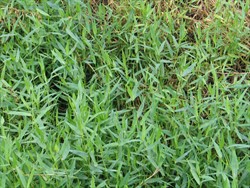
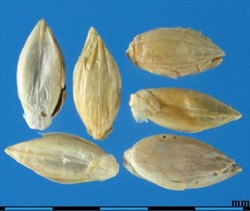 U. arrecta seeds
U. arrecta seeds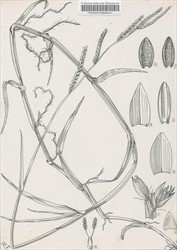
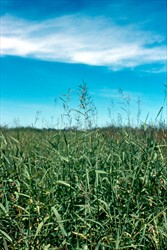
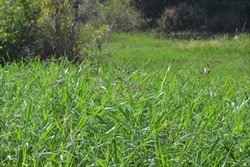
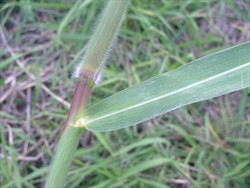 U. mutica densely bearded culm node; hairy leaf sheath
U. mutica densely bearded culm node; hairy leaf sheath